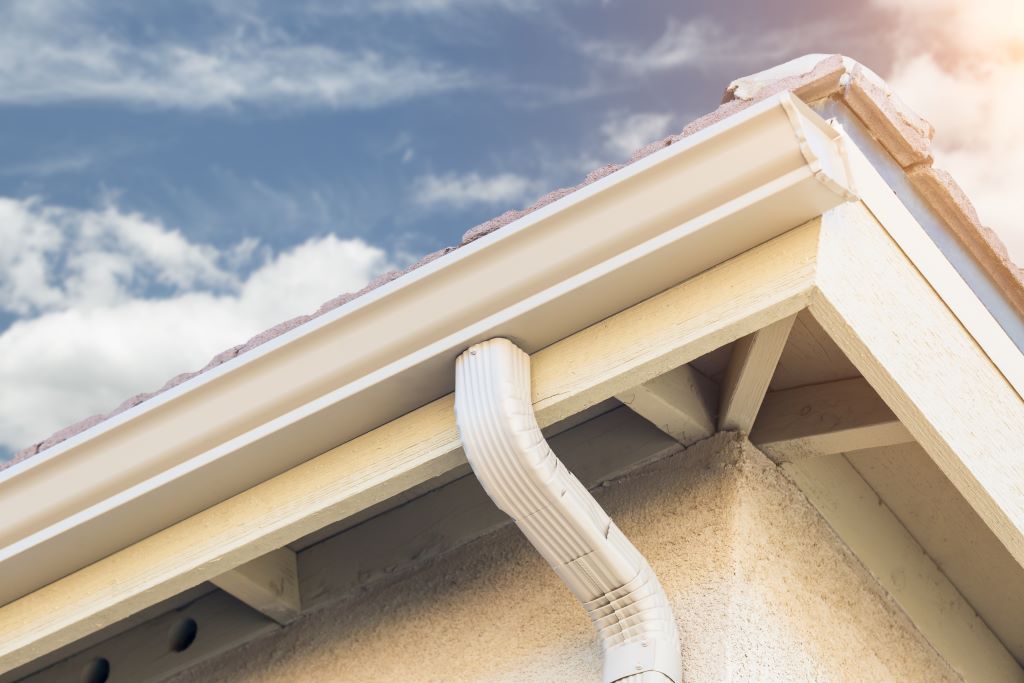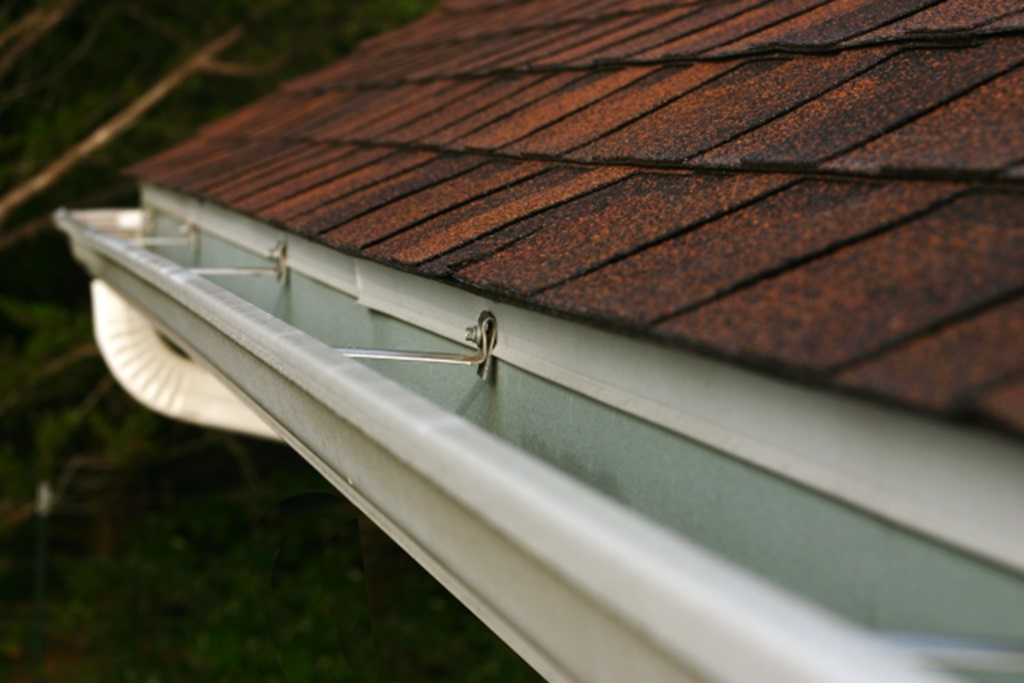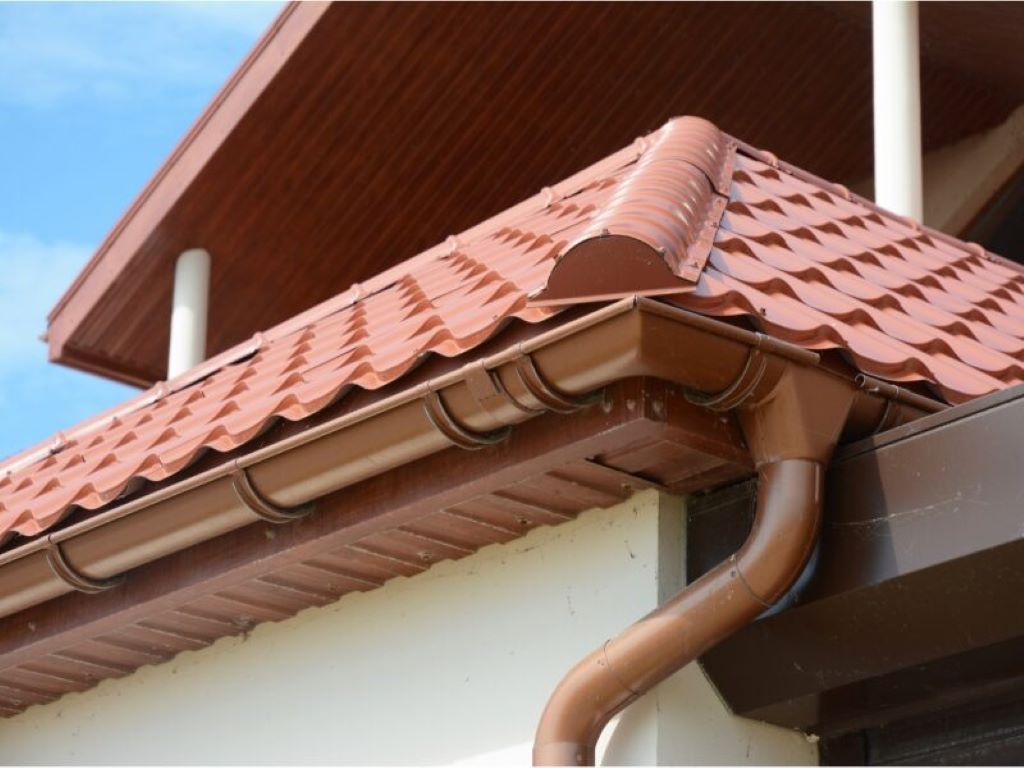
21 Jan What is Gutter Slope Requirements?
Gutters are an essential component of any home. They help collect and divert rainwater from your home’s foundation and prevent water damage. Having the proper slope or pitch is critical in ensuring gutters work correctly. The hill allows gravity to move water efficiently through the gutter system. Understanding gutter slope requirements can seem complicated at first. But getting it right is critical for adequate drainage and preventing problems like standing water, leaks, and overflowing gutters. This comprehensive guide covers everything you need to know about proper gutter slopes.
What is a Gutter Slope?
Gutter slope refers to the angle or pitch at which gutters are installed. It measures how many inches the gutter drops over a set horizontal distance. Slope is typically denoted as a ratio such as 1/4 inch per 10 feet. This means the gutter drops 1/4 inch for every 10 feet of horizontal run.
The proper gutter slope creates a downward angle that allows gravity to pull water smoothly through the gutters. With the appropriate slope, water flows towards downspouts without pooling up. Too little hill can lead to standing water and other drainage issues. Too steep a hill can result in fast water flow, causing gutters to overflow.

Why Gutter Slope Matters
Getting the ideal gutter slope for your home is essential for several reasons:
- Drainage effectiveness – The right slope results in proper drainage and carrying water away from your home. Insufficient slope leads to standing water, overflowing gutters, and more strain on your downspouts.
- Leak prevention – Water flows smoothly through gutter seams and connections with adequate slope. Insufficient pitch can result in leaks at seams and lead to water damage.
- Gutter durability – The ideal slope reduces strain on gutters. Standing water from a lack of slope can corrode and deteriorate gutters.
- Foundation protection – Effective slope diverts rainwater away from your foundation. Insufficient drainage from flat gutters can pool water around and seep into your foundation.
- Prevent overflows – An optimal slope carries runoff efficiently so gutters don’t overflow with heavy rain. Overflowing gutters lead to water spilling into areas where you don’t want it.
- Promote proper drainage – The right slope allows complete drainage into downspouts—lack of pitch results in standing water and moisture buildup that doesn’t drain properly.
Factors That Determine Slope
Several factors impact the ideal gutter slope for your particular home:
- Climate and rainfall – High rainfall areas need steeper slopes to divert significant volumes of water quickly. Drier climates can use a shallower pitch.
- Roof size and pitch – Steeper roofs and larger surface areas require a greater slope to drain faster without overflowing.
- Gutter type and size – Larger gutters allow you to use a flatter slope. Different gutter types, like K-style, also affect the ideal pitch.
- Downspout size and placement – Smaller downspouts need steeper slopes to prevent overflow. Downspout placement affects how quickly water needs to drain.
- Run length – Longer gutter runs require more slope, so water has momentum to make it to the downspout. Shorter runs can get by with less slope.
Your contractor should consider these factors when determining the proper gutter slope for your home.
Recommended Gutter Slopes
Most building codes and gutter manufacturers recommend a slope of 1/4 inch per 10 feet of gutter run. This results in a 2% slope. However, depending on your home’s specifics, the ideal slope can range between 1/8 inch to 1/2 inch per 10 feet,
Here are the commonly recommended minimum and maximum gutter slopes:
- Minimum slope: 1/8 inch per 10 feet (1% slope)
- Maximum slope: 1/2 inch per 10 feet (5% slope)
- Standard slope: 1/4 inch per 10 feet (2% slope)
You need 1/8 inch of drop per 10 feet to keep water moving. A 1/2 inch per 10-foot slope should be the steepest pitch to avoid overflowing. Most homes can use the typical 1/4 inch per 10 feet ratio.
Again, climate and roof pitch determine where your home should fall in this slope range. However, any slope within these parameters is considered acceptable and up to the building code.
Measuring and Calculating Slope
Figuring out the actual slope amount for your desired ratio can seem tricky. But it’s easily calculated using two main methods:
Using a Level and Tape Measure
This simple technique only requires a standard level and tape measure:
- Place one end of the level against the outlet of your gutter system or downspout.
- Measure horizontally along the level to your desired interval, such as 10 feet. Mark this point.
- Measure the vertical drop-down from the level to the gutter bottom at the mark. For a 1/4 inch per 10 feet slope, this should measure 1/4 inch.
- Adjust the gutter until the drop measurement matches your desired slope ratio.
Using Rise and Run Measurements
You can also calculate the slope by taking rise and run measurements:
- Run – The horizontal distance of the gutter, such as 10 feet.
- Rise – The vertical drop over the horizontal distance. For a 1/4 inch per 10 feet slope, the rise is 1/4 inch.
Once you have these figures, use the following formula:
Rise (in inches) ÷ Run (in feet) = Slope
For example:
1/4 inch rise ÷ 10 feet run = 0.025, which converts to a 2% slope
This shows the slope in percentage format rather than ratio. However, you can use the formula to calculate any desired slope ratio.
Tips for Proper Slope Installation
Here are some top tips for getting your gutter slope installed correctly:
- Use slope boards – Placing slope boards that match your desired pitch on the roof before installing gutters makes getting the angle right much more accessible.
- Work in sections – Measure and adjust the slope in shorter sections rather than tackle the entire gutter length at once.
- Check your work – Use a level and tape measure to verify the slope every few feet to ensure consistency.
- Account for sagging – Gutters tend to sag slightly over time, so build in a little extra slope (e.g., 3% instead of 2%) to allow for sag.
- Follow manufacturer’s advice – Consult your gutter manufacturer’s recommendations for proper slope, given your local climate and their gutter models.
- Consider downspout placement – Make sure downspouts are placed where the slope naturally allows for good drainage.
- Ask for help – Have an experienced gutter contractor install or double-check your slope settings to get it right.
Low-Slope Vs. Steep Slope Installation
There are some install differences between low- and steep-slope applications:
Low-Slope Gutters
Some homes, like those with flat roofs, require lower-slope gutters with more gradual pitches. Here are some tips for low-slope installations:
- Use more oversized gutters to compensate for less pitch.
- Widen downspouts to handle increased water volume.
- Add overflow drains to release excess water before the gutter overflows.
- Use stronger hangers and support brackets to prevent sagging.
- Double-check the slope often to ensure the minimum pitch is maintained.
Steep Slope Gutters
Homes with steep roofs often need gutters with steeper slopes:
- Use smaller gutter models that handle fast water flow better.
- Install more downspouts to drain the increased volume.
- Add downspout extenders to move water farther away from the home’s foundation.
- Attach gutter endcaps securely to prevent them from popping off from water pressure.
- Check that the slope doesn’t exceed the maximum recommended pitch.
Signs of Improper Gutter Slope

Watch for these issues, which indicate your gutters lack adequate slope:
- Standing water – When water pools in gutters, it’s a clear sign that the slope is insufficient. Standing water should drain within an hour after the rain stops.
- Leaky joints – Water will leak out of gutter seams if there’s not enough slope to move it down the system.
- Water overflow – Gutters that frequently overflow likely don’t have enough pitch to handle the water volume.
- Moisture on fascia – Improperly pitched gutters often allow water to overflow and run down the fascia board.
- Downspout overflow – Gutters overflowing into downspouts indicate excess water caused by lack of slope.
- Corrosion or rot – Standing water from insufficient drainage will corrode gutters and cause wood rot over time.
- Paint peeling – Runoff moisture from overflowing low-slope gutters can get behind the paint and cause peeling.
- Foundation damage – Poor drainage from flat gutters allows water to pool against and seep into your foundation.
- Erosion and staining – Concentrated runoff from improperly pitched gutters can erode soil and stain surfaces.
- Pest infestations – Standing water attracts mosquitos to breed and carpenter ants that can damage wood gutters.
Correcting Insufficient Gutter Slope
If you’re dealing with drainage issues, there are a few ways to remedy insufficient gutter slope:
- Adjust hangers – For minor slope issues, adjusting gutter hangers to tip gutters slightly can improve the pitch.
- Add slope boards – Installing rigid boards under gutters is an easy way to increase pitch.
- Re-slope gutters – Removing and re-installing gutters is effective for fully correcting slopes.
- Replace gutters – Replacement may be needed for older gutters with significant sagging and pooling issues.
- Install downspout extenders – Extenders help move overflow water away from the home.
- Add downspouts – Extra downspouts improve drainage for long gutter runs.
- Upgrade downspout size – Wider downspouts may be needed to handle increased capacity.
- Install overflow drains – Drains release excess water buildup from insufficiently sloped gutters.
FAQs
How much slope do most gutters need?
The standard recommendation is 1/4 inch of drop per 10 feet of gutter, which creates a 2% slope. Most homes can use this ratio, but anywhere from 1/8 inch to 1/2 inch per 10 feet is acceptable.
Can gutters be too steep?
Yes, gutters with excessive slopes beyond an inch per 10 feet can overflow quickly with heavy rain. The maximum recommended pitch is 1/2 inch per 10 feet.
How often should I check the gutter slope?
Inspect your gutters at least twice a year and after major storms. Watch for signs of standing water or overflow, indicating insufficient slope.
Do downspouts affect gutter slopes?
Yes, downspout size and placement impact how quickly water must drain, so they factor into proper slope requirements.
How do I increase the slope on sagging gutters?
You can add slope boards for minor sagging. For more severe sagging, removing and re-installing the gutters correctly is best.
Conclusion
Calculating the proper gutter slope and getting your gutters pitched correctly is crucial for adequate drainage and preventing water damage. Follow the recommended 1/4 inch per 10-foot ratio, but adjust for your roof type and climate as needed. To soundproof between two houses effectively, pay attention to potential issues such as pooling water, overflow, and leaks. Keep an eye out for these signs to spot any insufficient slope in your gutter system. Additionally, ensure that a qualified professional installs or inspects the gutter slope, as a proper pitch is crucial for efficiently diverting rainwater away from your home.



Sorry, the comment form is closed at this time.